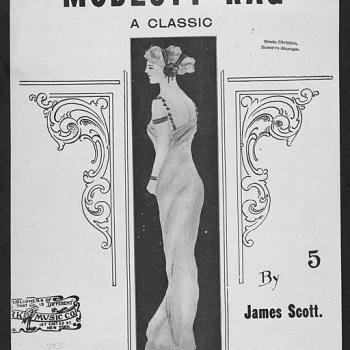While the “sola skirtura” debate raging elsewhere in the Catholic blogosphere is not interesting to me personally, the torrid ground from which it springs is. For some of the skirts-only enthusiasts, the matter is ostensibly a question of femininity. For others, it’s a question of whether women in pants are in commission of a sin, or are providing men with a near occasion of sin, by allowing the outline of their lower bodies to be seen, however discreetly, rather than simply inferred. As a woman who, after my reversion to the Catholic Church, found myself wading into the waters of orthodox Catholic dating, I can’t help but thinking that men who get hot and bothered about women wearing pants are coming from a place of sexual woundedness.
When, after a lackadaisical childhood catechesis, years spent doing my own thing, and a dramatic conversion experience, I came back to the Catholic Church in 2002, I found that there was a New York City subculture I had never known existed, that of young orthodox and Traditionalist Catholics. Many of this subculture’s adherents were actively looking for a mate, and I dated a few of them, which was an experience unlike anything I was familiar with from my own romantic struggles. Many of the men I met in this subculture seemed to be essentially wounded in their masculinity. It was as if their sense of manhood had been deliberately constructed out of subversive images of masculinity refracted to them from the culture; as if, finding certain norms of masculinity repellent (not without reason, it must be said), and not having viable male role models to demonstrate how a strong Catholic manhood might appear, they had skirted, so to speak, the edges of male behavior and had finished by taking affect for essence. Their own visions of manhood seemed to have been forged in negation, cobbled together out of sometimes-strident opposition to what repelled them culturally, rather than stemming from any positive desire to take on meaningful male roles — fighting real enemies, for instance, or providing for and protecting the vulnerable, including women and children. In addition, some of these men self-consciously adopted styles, tastes, hobbies, and mannerisms associated with other times and places than twenty-first-century New York City, identifying themselves with, say, Mitteleuropa before World War I, or fin-de-siècle Paris, or New York in the Gilded Age.
By suggesting their sexual woundedness, I do not mean to imply that these men were homosexual. In fact, I never got close enough to any of them to be able to speak with authority to their actual sexual proclivities or problems. I believe that at least one man from this subculture whom I dated had a problem with pornography, based on some oblique conversational hints he let drop, as well as on the fact that, after we had decided to stop seeing each other and I was engaged to someone else, he sent me a bizarre email containing soft-porn images. This particular man was employed in a field related to Catholic apologetics, and I do not mean to suggest that to be a successful, or even a sincere, apologist, one must be free from dark sexual neuroses and addictions. Only God knows what is in the hearts of any of us, including — as we have seen lately in the case of the disgraced Fr. Corapi — of the priest who is saying Mass, and of those who hear him say it on a daily basis, even those who insist on hearing him say it in Latin and ad orientem; only God knows what snares even they must run from each and every day of their lives in order to escape falling into the hells that are peculiarly and horribly familiar to each of them. I am simply saying that the combination of qualities I saw in this subculture, or at least in this particular member of it — a shrinking from ontological maleness, a way of being a man that seemed gerry-built upon opposition to accepted standards of masculinilty, a self-professed orthodox Catholicism veering towards Traditionalism, and some deep-seated sexual problems — strike me now as disturbingly emblematic of a certain type of Catholic man.
Nor do I mean to suggest that I am not also sexually wounded myself, or that, as I mentioned earlier, sexually-wounded men cannot be apologists. I am, and they can. It is when they write or speak out of a poorly-hidden crisis in their own masculinity, which I believe is a reflection of a wider cultural crisis in essential masculinity, that I get worried for women, especially for orthodox Catholic women who want to marry orthodox Catholic men. Some of these men seem to be trying to regain an impossible Edenic ideal of manhood and fatherhood that they may never have experienced in their own lives. Others, perhaps unconsciously, appear to be doing everything possible to avoid the self-sacrifice called for in marriage and fatherhood by attempting to disassociate themselves from any accepted cultural norms of masculinity, and, in so doing, fail to present themselves to eligible women as viable potential husbands and fathers.
I am as much an authority on the Theology of the Body as I am on the arcana of the skirts-vs.-pants debate, which is to say not at all. But I wonder sometimes if TOB, like male obsession with female modesty, presents a sort of utopianism to orthodox Catholic men — an antidote to the dystopias of pornography, to be sure, but no more realistic. We are all essentially wounded, and sex, whether contracted within a sacramental marriage or not, is not the cure. The only hope we have for healing is in our capacity to love the unlovable, and to be able to love each other as who and where we are. And who and where we are is, at bottom, broken and disabled by sin. The ontological substance of masculinity is not the ability to oppose and negate, but the willingness to serve and protect, while the ontological substance of femininity is not the willingness to shun pants, but the ability to nurture goodness and to reveal beauty. Most of us are, of course, wounded in these capacities, but when one of us acts out of this woundedness and does damage to others as a result, the entire Mystical Body of Christ suffers. I hope and pray that priests and laypeople might work together to heal those who are wounded in their essential sexuality — i.e., our brothers and sisters and ourselves — which would go a long way, too, towards healing relations between Catholic men and women.












